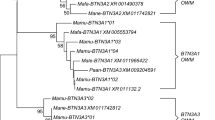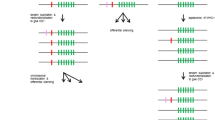Abstract
Human Vγ9Vδ2 T cells recognize phosphorylated products of isoprenoid metabolism (phosphoantigens) PAg with TCR comprising Vγ9JP γ-chains and Vδ2 δ-chains dependent on butyrophilin 3 (BTN3) expressed by antigen-presenting cells. They are massively activated in many infections and show anti-tumor activity and so far, they have been considered to exist only in higher primates. We performed a comprehensive analysis of databases and identified the three genes in species of both placental magnorders, but not in rodents. The common occurrence or loss of in silico translatable Vγ9, Vδ2, and BTN3 genes suggested their co-evolution based on a functional relationship. In the peripheral lymphocytes of alpaca (Vicugna pacos), characteristic Vγ9JP rearrangements and in-frame Vδ2 rearrangements were found and could be co-expressed in a TCR-negative mouse T cell hybridoma where they rescued CD3 expression and function. Finally, database sequence analysis of the extracellular domain of alpaca BTN3 revealed complete conservation of proposed PAg binding residues of human BTN3A1. In summary, we show emergence and preservation of Vγ9 and Vδ2 TCR genes with the gene of the putative antigen-presenting molecule BTN3 in placental mammals and lay the ground for analysis of alpaca as candidate for a first non-primate species to possess Vγ9Vδ2 T cells.







Similar content being viewed by others
Abbreviations
- PAg:
-
phosphoantigen
- BTN:
-
Butyrophilin
- Vp:
-
Vicugna pacos
- HMBPP:
-
(E)-4-hydroxy-3-methyl-but-2-enyl pyrophosphate
- IPP:
-
Isopentenyl pyrophosphate
- BTN3A1-ED:
-
Butyrophilin 3 A1 extracellular domain
References
Allison TJ, Winter CC, Fournie JJ, Bonneville M, Garboczi DN (2001) Structure of a human gammadelta T-cell antigen receptor. Nature 411:820–824
Arden B, Clark SP, Kabelitz D, Mak TW (1995) Mouse T-cell receptor variable gene segment families. Immunogenetics 42:501–530
Asher RJ, Bennett N, Lehmann T (2009) The new framework for understanding placental mammal evolution. Bioessays 31:853–864
Bonneville M, O’Brien RL, Born WK (2010) Gammadelta T cell effector functions: a blend of innate programming and acquired plasticity. Nat Rev Immunol 10:467–478
Clark SP, Arden B, Kabelitz D, Mak TW (1995) Comparison of human and mouse T-cell receptor variable gene segment subfamilies. Immunogenetics 42:531–540
Daubenberger CA, Salomon M, Vecino W, Hubner B, Troll H, Rodriques R, Patarroyo ME, Pluschke G (2001) Functional and structural similarity of V gamma 9V delta 2 T cells in humans and Aotus monkeys, a primate infection model for Plasmodium falciparum malaria. J Immunol 167:6421–6430
Frota CC, Lima LN, Rocha Ada S, Suffys PN, Rolim BN, Rodrigues LC, Barreto ML, Kendall C, Kerr LR (2012) Mycobacterium leprae in six-banded (Euphractus sexcinctus) and nine-banded armadillos (Dasypus novemcinctus) in Northeast Brazil. Mem Inst Oswaldo Cruz 107(Suppl 1):209–213
Gober HJ, Kistowska M, Angman L, Jeno P, Mori L, De Libero G (2003) Human T cell receptor gammadelta cells recognize endogenous mevalonate metabolites in tumor cells. J Exp Med 197:163–168
Harly C, Guillaume Y, Nedellec S, Peigne CM, Monkkonen H, Monkkonen J, Li J, Kuball J, Adams EJ, Netzer S, Dechanet-Merville J, Leger A, Herrmann T, Breathnach R, Olive D, Bonneville M, Scotet E (2012) Key implication of CD277/butyrophilin-3 (BTN3A) in cellular stress sensing by a major human gammadelta T-cell subset. Blood 120:2269–2279
Hartig G, Churakov G, Warren WC, Brosius J, Makalowski W, Schmitz J (2013) Retrophylogenomics place tarsiers on the evolutionary branch of anthropoids. Sci Rep 3:1756
Hayday AC (2000) [gamma][delta] cells: a right time and a right place for a conserved third way of protection. Annu Rev Immunol 18:975–1026
Hein WR, Mackay CR (1991) Prominence of gamma delta T cells in the ruminant immune system. Immunol Today 12:30–34
Herzig C, Blumerman S, Lefranc MP, Baldwin C (2006) Bovine T cell receptor gamma variable and constant genes: combinatorial usage by circulating gammadelta T cells. Immunogenetics 58:138–151
Kabelitz D, He W (2012) The multifunctionality of human Vgamma9Vdelta2 gammadelta T cells: clonal plasticity or distinct subsets? Scand J Immunol 76:213–222
Kalyan S, Kabelitz D (2013) Defining the nature of human gammadelta T cells: a biographical sketch of the highly empathetic. Cell Mol Immunol 10:21–29
Kasmar A, Van Rhijn I, Moody DB (2009) The evolved functions of CD1 during infection. Curr Opin Immunol 21:397–403
Kazen AR, Adams EJ (2011) Evolution of the V, D, and J gene segments used in the primate gammadelta T-cell receptor reveals a dichotomy of conservation and diversity. Proc Natl Acad Sci U S A 108:E332–E340
Kreiss M, Asmuss A, Krejci K, Lindemann D, Miyoshi-Akiyama T, Uchiyama T, Rink L, Broeren CP, Herrmann T (2004) Contrasting contributions of complementarity-determining region 2 and hypervariable region 4 of rat BV8S2+ (Vbeta8.2) TCR to the recognition of myelin basic protein and different types of bacterial superantigens. Int Immunol 16:655–663
Kuss AW, Knodel M, Berberich-Siebelt F, Lindemann D, Schimpl A, Berberich I (1999) A1 expression is stimulated by CD40 in B cells and rescues WEHI 231 cells from anti-IgM-induced cell death. Eur J Immunol 29:3077–3088
Litman GW, Rast JP, Fugmann SD (2010) The origins of vertebrate adaptive immunity. Nat Rev Immunol 10:543–553
Martin E, Treiner E, Duban L, Guerri L, Laude H, Toly C, Premel V, Devys A, Moura IC, Tilloy F, Cherif S, Vera G, Latour S, Soudais C, Lantz O (2009) Stepwise development of MAIT cells in mouse and human. PLoS Biol 7:e54
Monzon-Casanova E, Paletta D, Starick L, Muller I, Sant’Angelo DB, Pyz E, Herrmann T (2013) Direct identification of rat iNKT cells reveals remarkable similarities to human iNKT cells and a profound deficiency in LEW rats. Eur J Immunol 43:404–415
Morita CT, Jin C, Sarikonda G, Wang H (2007) Nonpeptide antigens, presentation mechanisms, and immunological memory of human Vgamma2Vdelta2 T cells: discriminating friend from foe through the recognition of prenyl pyrophosphate antigens. Immunol Rev 215:59–76
O’Leary MA, Bloch JI, Flynn JJ, Gaudin TJ, Giallombardo A, Giannini NP, Goldberg SL, Kraatz BP, Luo ZX, Meng J, Ni X, Novacek MJ, Perini FA, Randall ZS, Rougier GW, Sargis EJ, Silcox MT, Simmons NB, Spaulding M, Velazco PM, Weksler M, Wible JR, Cirranello AL (2013) The placental mammal ancestor and the post-K-Pg radiation of placentals. Science 339:662–667
Palakodeti A, Sandstrom A, Sundaresan L, Harly C, Nedellec S, Olive D, Scotet E, Bonneville M, Adams EJ (2012) The molecular basis for modulation of human Vgamma9Vdelta2 T cell responses by CD277/butyrophilin-3 (BTN3A)-specific antibodies. J Biol Chem 287:32780–32790
Pyz E, Naidenko O, Miyake S, Yamamura T, Berberich I, Cardell S, Kronenberg M, Herrmann T (2006) The complementarity determining region 2 of BV8S2 (V beta 8.2) contributes to antigen recognition by rat invariant NKT cell TCR. J Immunol 176:7447–7455
Richards MH, Nelson JL (2000) The evolution of vertebrate antigen receptors: a phylogenetic approach. Mol Biol Evol 17:146–155
Scotto-Lavino E, Du G, Frohman MA (2006) 3′ end cDNA amplification using classic RACE. Nat Protoc 1:2742–2745
Sharma R, Lahiri R, Scollard DM, Pena M, Williams DL, Adams LB, Figarola J, Truman RW (2013) The armadillo: a model for the neuropathy of leprosy and potentially other neurodegenerative diseases. Dis Model Mech 6:19–24
Sicard H, Ingoure S, Luciani B, Serraz C, Fournie JJ, Bonneville M, Tiollier J, Romagne F (2005) In vivo immunomanipulation of V gamma 9V delta 2 T cells with a synthetic phosphoantigen in a preclinical nonhuman primate model. J Immunol 175:5471–5480
Springer MS, Stanhope MJ, Madsen O, de Jong WW (2004) Molecules consolidate the placental mammal tree. Trends Ecol Evol 19:430–438
Tazi-Ahnini R, Henry J, Offer C, Bouissou-Bouchouata C, Mather IH, Pontarotti P (1997) Cloning, localization, and structure of new members of the butyrophilin gene family in the juxta-telomeric region of the major histocompatibility complex. Immunogenetics 47:55–63
Turchaninova MA, Britanova OV, Bolotin DA, Shugay M, Putintseva EV, Staroverov DB, Sharonov G, Shcherbo D, Zvyagin IV, Mamedov IZ, Linnemann C, Schumacher TN, Chudakov DM (2013) Pairing of T-cell receptor chains via emulsion PCR. Eur J Immunol 43:2507–2515
Vantourout P, Hayday A (2013) Six-of-the-best: unique contributions of gammadelta T cells to immunology. Nat Rev Immunol 13:88–100
Vavassori S, Kumar A, Wan GS, Ramanjaneyulu GS, Cavallari M, El Daker S, Beddoe T, Theodossis A, Williams NK, Gostick E, Price DA, Soudamini DU, Voon KK, Olivo M, Rossjohn J, Mori L, De Libero G (2013) Butyrophilin 3A1 binds phosphorylated antigens and stimulates human gammadelta T cells. Nat Immunol 14(9):908–916
Wang H, Lee HK, Bukowski JF, Li H, Mariuzza RA, Chen ZW, Nam KH, Morita CT (2003) Conservation of nonpeptide antigen recognition by rhesus monkey V gamma 2V delta 2 T cells. J Immunol 170:3696–3706
Wang H, Fang Z, Morita CT (2010) Vgamma2Vdelta2 T Cell receptor recognition of prenyl pyrophosphates is dependent on all CDRs. J Immunol 184:6209–6222
Wang H, Henry O, Distefano MD, Wang YC, Raikkonen J, Monkkonen J, Tanaka Y, Morita CT (2013) Butyrophilin 3A1 plays an essential role in Prenyl pyrophosphate stimulation of human vgamma2Vdelta2 T Cells. J Immunol 191:1029–1042
Welsh MD, Kennedy HE, Smyth AJ, Girvin RM, Andersen P, Pollock JM (2002) Responses of bovine WC1(+) gammadelta T cells to protein and nonprotein antigens of Mycobacterium bovis. Infect Immun 70:6114–6120
Wilhelm M, Kunzmann V, Eckstein S, Reimer P, Weissinger F, Ruediger T, Tony HP (2003) Gammadelta T cells for immune therapy of patients with lymphoid malignancies. Blood 102:200–206
Wilson IA, Stanfield RL (2001) Unraveling the mysteries of gammadelta T cell recognition. Nat Immunol 2:579–581
Acknowledgments
We thank Thomas Dandekar for his suggestions in phylogenetic analysis and revising the manuscript.
Conflict of interest
The authors declare no competing financial interests.
Author information
Authors and Affiliations
Corresponding author
Additional information
Authors Contribution
M.M.K and T.H. conceived the study and wrote the manuscript. M.M.K., T.H., T.G., and L.W. designed and interpreted the experiments. T.G provided biological specimens. M.M.K. performed most experiments including data base analysis. L.S. performed experiments. All authors have seen and approved the manuscript.
M.M.K. was supported by a grant of the German Excellence Initiative to the Graduate School of Life Sciences, University of Würzburg and the DAAD STIBET Doktoranden program
Electronic supplementary material
Below is the link to the electronic supplementary material.
ESM 1
(PDF 584 kb)
Rights and permissions
About this article
Cite this article
Karunakaran, M.M., Göbel, T.W., Starick, L. et al. Vγ9 and Vδ2 T cell antigen receptor genes and butyrophilin 3 (BTN3) emerged with placental mammals and are concomitantly preserved in selected species like alpaca (Vicugna pacos). Immunogenetics 66, 243–254 (2014). https://doi.org/10.1007/s00251-014-0763-8
Received:
Accepted:
Published:
Issue Date:
DOI: https://doi.org/10.1007/s00251-014-0763-8




